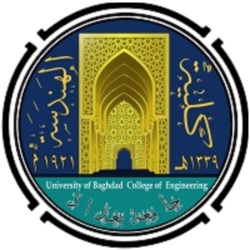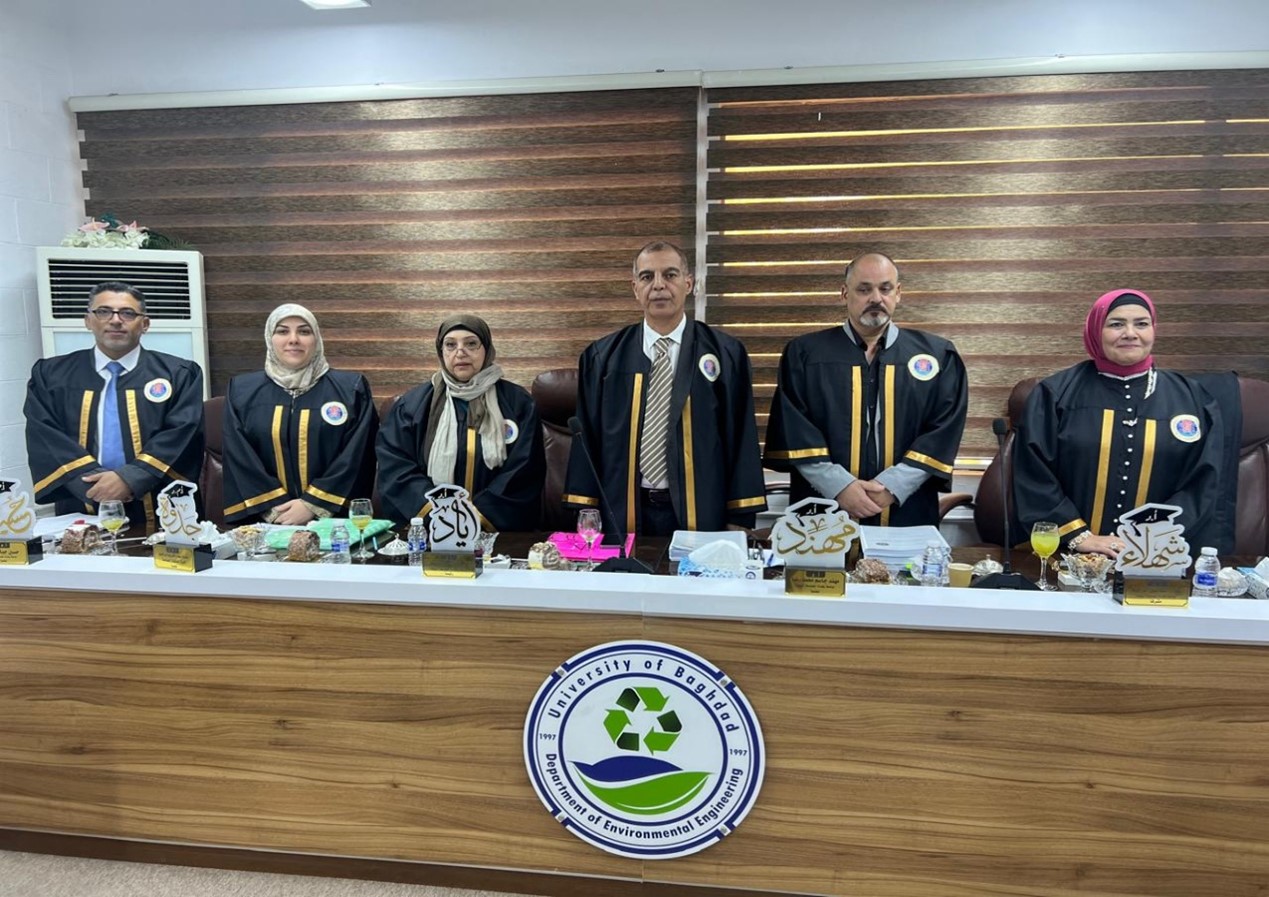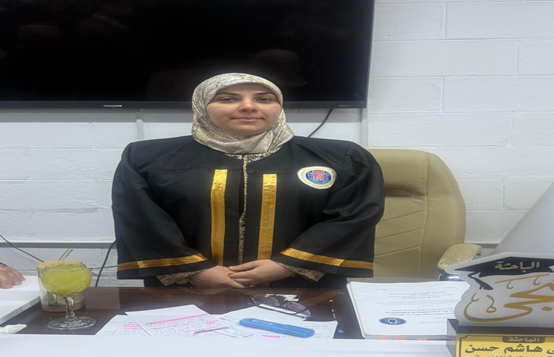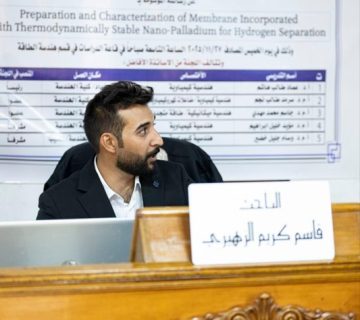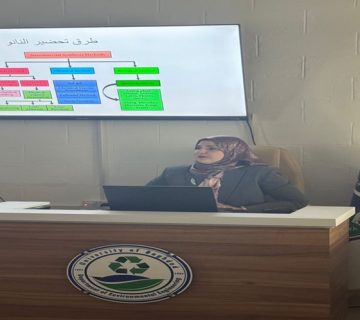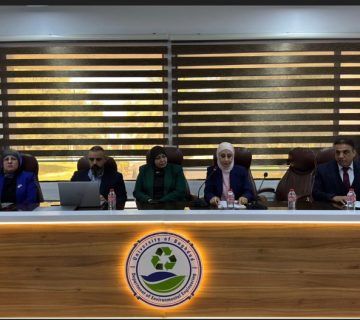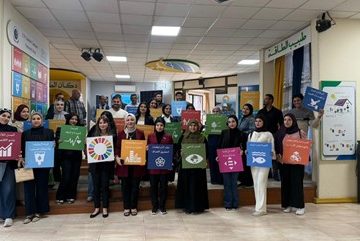Environmental Engineering Department at the College of Engineering, University of Baghdad, held PhD dissertation examination titled:
“Using core-shell and supported nanocomposites as efficient photocatalysts for dyes removal and microbial inactivation”
By the student Saja Hashim Hassan and supervised Prof. Dr. Shahla Ismail Ibrahem on Thursday 16/10/2025, in the Environmental Engineering discussion hall. The examination committee consisted of Prof. Dr. Ayad Abdul Hamza Fasal as Chairman, and the membership of Prof. Dr. Mohanad Jasim Mohammed Reda, Assist.Prof. Dr. Jethwa Abdul Kareem Ibrahim, Assist. Prof. Dr. Hussein Gabbar Kadhim and Assist. Prof. Dr. Mohammed Bahjat Abdul-Kareem. After conducting the public discussion and listening to the student’s defense, the dissertation was accepted. It was summarized as follows:
In this study, the magnetic heterogeneous nanocomposite photocatalysts in both core/shell (CoFe2O4@CuO@Ag3VO4) and supported structures (CoFe2O4/CuO/Ag3VO4) were synthesized via a facile multistep method. However, two modification approaches were developed; semiconductor heterojunction and surface modification, to address the drawbacks related to use single photocatalysts through reducing the recombination rate of electron/hole pairs, expanding the absorption of light in the visible region, and modifying the bandgap energy. Several characterization techniques such as X-ray diffraction (XRD), Field emission scanning electron microscopy (FE-SEM), Transmission electron microscope (TEM), Vibrating sample-magnetometer (VSM), Brunauer-Emmett-Teller (BET), Barrett-Joyner-Halenda (BJH), and UV-visible diffuse reflector spectroscopy (UV-vis DRS), were used to confirm the formation of the two composites.The photocatalytic activity of fabricated photocatalysts was investigated against methylene blue (MB) and Congo red (CR) dyes degradation, and Escherichia coli (E. coli) inactivation under visible light irradiation. The core/shell composite demonstrated superior photocatalytic degradation activity against MB and CR (99.7% and 98.8% removal efficiencies in 90 min, respectively). As well as completely inactivated performance against E. coli in 120 min. On the other hand, in the presence of supported composite, 93.8% of MB and 89.6% of CR were degraded in 90 min, and the E. coli cell was completely destroyed in 120 min. Furthermore, the kinetics results of both core/shell and supported composites were well matched with the pseudo-first-order model. More importantly, the operation parameters such as catalyst dose, initial pollutant concentration, solution pH, and H2O2 addition showed significant effects on the photocatalytic activity of synthesized photocatalysts. In addition, the photocatalytic performance of core/shell composites was successfully analyzed by multiple linear regression models (Inter model) using the SPSS software (version 26). The scavenger experiments revealed the role of each reactive species (•OH, •O2−, H2O2, h+, e−) in photocatalytic reactions. It was detected that the reactive species contributions of core/shell and supported composites were arranged in the following order: H2O2 > h+ > e− > •O2– > •OH and •OH > H2O2 > h+ > e− > •O2–, respectively. The photocatalytic mechanisms of MB, CR degradation, and E. coli inactivation were well explained based on the UV-vis DRS analysis and scavenger experiments. Finally, the synthesized photocatalysts exhibited remarkable stability after five successive running cycles without significant losses in their photocatalytic properties. In addition, simple magnetic separation process allowed the photocatalysts to be reused efficiently, suggesting their applicability in wastewater treatment as photocatalysis agents. The Recommendations of this dissertation.
In light of the findings and limitations of the current study, the following recommendations are proposed to guide future researchers aiming to build upon and further develop this work:
Study the possibility of replacing the CoFe2O4 core with CoFe3O4 semiconductor due to its magnetic and optical properties Other photoactive supporting structures, such as ZnO, GO, g-C3N4, rGO, etc., can be used instead of CoFe2O4.Investigating the effect of other operating parameters such as reaction temperature, light intensity, wavelength, inorganic salt, etc. Investigating the photocatalytic degradation activity against other organic pollutants such as rhodamine B (RhB), methylene orange (MO), acid orange 7 (AO7), phenol, aldehyde, tetracycline, pesticides, etc. Study the possibility of inactivating other pathogenic microbes, such as S. aureus, P. aeruginosa, B. subtilis, and Clostridium perfringens. Investigating the photocatalytic performance against a mixture of microbes in real wastewater.
